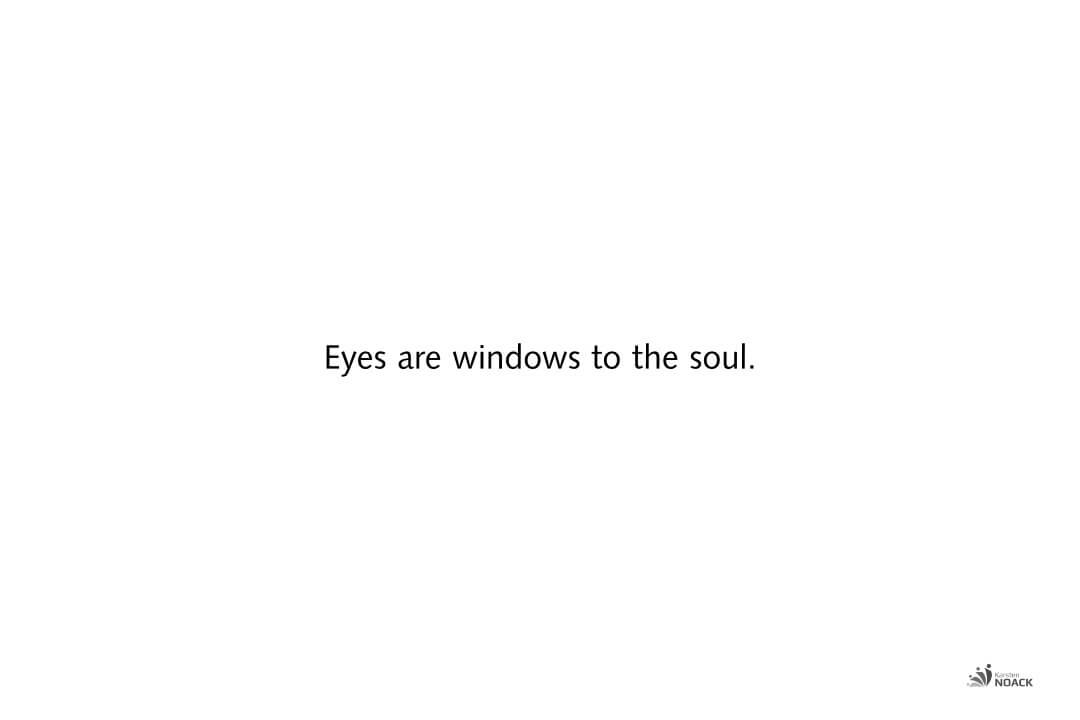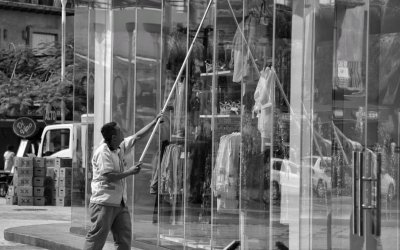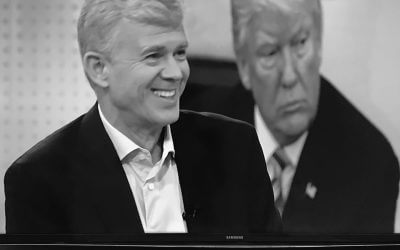Body language: What can actually be read from the eyes? Not only wishes!
Learn to read body language: the eyes
Look into my eyes!
What can be read from the eyes? More than wishes! The eyes have a big part in human facial expressions. There is a reason why the eyes are called the mirror of the soul. They reveal a lot about our feelings and thoughts, no matter if we want them or not. Eyes can smile, radiate joy, permeate, agree, question, doubt or reject. Learn to read body language.
Overview
When the eyes say one thing, and the tongue another, a practiced man relies on the language of the first.
Ralph Waldo Emerson
What the eyes can tell
The eyes have a big part in human facial expressions. Apart from the people with dark or mirrored sunglasses, visual signals are quite easy to recognize and interpret. There is a reason why the eyes are called the mirror of the soul. They reveal much about our feelings and thoughts, whether we like them or not. Eyes can smile, radiate joy, permeate, agree, question, doubt or reject. A cursing gaze can even hurt other people without supernatural powers.
Why paying attention to eye contact?
You only see well with the heart, the essential is invisible to the eyes.
Antoine de Saint-Exupery
Why is it worthwhile dealing with the topic of eye contact? Because people often have unspoken goals with their eye contact:
- The search for further information
- Expression of attention and interest
- Endeavoring to influence, dominate or deter other people
- Provide feedback
- Invitation and control of human interactions
- Something is to be hidden
Interpretations: Read from the eyes
A gaze can hit and even hurt other people. There is the withering look and some even wish that looks could kill. Sometimes the eyes say something other than the conscious mind-controlled words that leave the mouth. That’s another reason why it’s worth watching.
For the following body signals, I have added a selection of possible interpretations. Important in the analysis of body language: always calibrate well and evaluate the clues in clusters. Only then can well-founded working theses be developed.
You can use the elements yourself in your body language. Insofar as the signals are consciously controllable, you can decide for yourself whether they support your intended message or not.
1. Avoiding eye contact
Possible interpretations: Someone is looking for an alternative and escape possibilities.
If a situation is perceived as unpleasant or even dangerous, eye contact is often avoided. This is also because of self-confidence. In the assessment, the previous calibration helps.
2. Longer compressing of the eyelids
Possible interpretation: Someone got scared.
If the eyes are closed for longer than is the usual lid reflex, this may be due to too bright a light or a more violent shock. In the latter case, sufferers often want to close their eyes to reality.
3. The direction of view
a.) A lowered gaze outside of conversations
Possible interpretation: disinterest
Outside of a conversation someone in the environment lowers the view or does not respond at all to the attempt to make eye contact, then there is no interest on his part (at least for the moment).
b.) A lowered gaze during conversations
Possible interpretations: malaise, insecurity, lies
If someone lowers their eyes during a conversation, it can be an indication that they are feeling uncomfortable. Eye contact is omitted, to give no evidence of lies. But as often mentioned; these are clues, not clear proofs.
c.) An oblique gaze
Possible interpretation: It means appraising restraint
An oblique gaze often signals to appraise restraint and is often deliberately used.
d.) Eyes to the ground
Possible interpretations: insecurity, ignorance or provocation
If the gaze goes steadily or frequently to the ground, moves restlessly back and forth, seems to be looking for something, the eyes are pulled together, the eyebrows are raised or are demonstratively turned in a different direction – then they are indications for insecurity, ignorance or also for provocation.
e.) The degree of eye-opening
Possible interpretations: interest, concentration, sleep deficit
The degree of eye-opening allows conclusions about how alert someone is. Open eyes indicate interest, contracted eyes indicate concentration.
4. Focusing with the eyes
a.) The focus on something
Possible interpretation: concentration
Concentration instantly stiffens the neck to focus on one point.
5. Staring
Possible interpretations: aggression or shock reaction
Stare is very often an attack reaction. It is often perceived as aggressive and threatening due to this target fixation. It can also be a shock reaction in which someone is so frozen that the gaze freezes and can not be averted.
6. Pupils
a.) The pupil dilation
There were times when women dribbled the juice of the nightshade into their eyes to dilate the pupils. The belladonna is therefore also called Artopa Belladonna (beautiful woman) because dilated pupils are considered more attractive and are registered unconsciously. Without such manipulation, one can guess how attracted someone feels about what he is looking at.
Possible interpretations: joy, pleasure, sympathy
If great pleasure is felt, then eyes and pupils enlarge. Some poker players wear sunglasses to hide their reactions to a good hand.
7. The blinking of the eyes
a.) Uneasy blinking
Normal is a blink frequency of 10 to 20 times per minute.
Possible interpretations: insecurity, surprise, stress, lies
An uneasy wink prevents longer eye contact and thus has little trustworthiness. More adrenaline is released during lying, resulting in increased eyelid beat. This stress reaction can have other triggers.
b.) Very rare blinking
Possible interpretation: boredom
An unusually low blink frequency of the listener in certain phases of conversations and presentations indicates that they have lost their attention. However, very few speakers register this.
8. Eyebrows
Only the interplay of eyebrows and eyes allows interpretations within clusters (a combination of possible hints).
a.) Eyes and eyebrows are pinched.
Often it is smiled on one side, so only one corner of the mouth is pulled up or only one side pulls inwards.
Possible interpretations: skepticism and contempt
The gaze is so focused and concentrated; someone is gazing skeptically.
b.) Eyebrows go down and eyes narrow
The eyebrows are pulled down and the eyes narrow, while the upper eyelids often raise and contract. The otherwise curved lower eyelid straightens while, below the eyelid are small wrinkles.
Possible interpretation: anger
The more pronounced the facial expressions, the greater the annoyance.
c.) The simultaneous lifting and contracting of the eyebrows.
Possible interpretations: grief and anger
Simultaneous lifting and contracting of eyebrows are common in people who are mourning and annoyed.
d.) Temporary raising of the eyebrows, where the eyes continue to open
While the eyebrows are pulled up, wrinkles in the forehead area usually form. Possible interpretations: an expression of joyous surprise and increased attention. If the surprise is greater, the chin also lowers. Sometimes so far that the mouth opens.
e.) Eyebrows raised in combination with a slight lift of the head
Possible interpretation: disapproval
9. Spontaneously developed wrinkles around the eyes with a laughing mouth
Possible interpretation: Real laugh
A true smile (Duchenne smile) involves many muscles. It is accompanied by the lowering of the eyebrows and the activation of the muscles around the eye (Orbicularis oculi). In contrast, the simulated smile does not activate the muscles around the eyes. Often a false smile breaks off abruptly or gradually disappears from the face.
10. Eye movements
With generalizations, that is often such a thing. Unfortunately, the concept of eye access, from NLP (Neuro-Linguistic Programming), is often misunderstood. Often, things are too simplistic: when a person says the truth, he looks to the left. If he lies, his eyes move to the right. But that’s not how it works in practice. In reality, it is a bit more complex. Few users calibrate neatly enough and do not have the flexibility to use such hints.
Who mastered the concept, receives many additional hints up to insights into the personal thinking strategies of interlocutors.

Recommendations for your eye contact
Eyes speak volumes. A look can say more than a thousand words. It is therefore advisable to give interlocutors an open view for a few seconds, accompanied by a contagious friendly smile.
A friendly open look makes listeners feel positive. Those who do not pay any attention to other people are considered arrogant and unsympathetic. Those who want to convince people of themselves and their offers benefit from good eye contact. But beware of too-long eye contact. This can easily be interpreted as staring, crossing the border, and being rude. Who fixes someone too long and too intensely, is quickly regarded as threatening and aggressive.
In principle, it is easy. You communicate with your eyes what’s going on in you. If you are excited about something, your eyes will sparkle and that is contagious!
Be ready for important conversations and negotiations
Communication can be easy. But often it is not. Sometimes we say one thing and then realize later, based on the other person's reaction, that they were talking to someone else. With the best will in the world, I didn't say that. - Or did I?
More or less consciously, conversations are about convincing other people of something - be it a special offer, your personality, a perspective, or a necessity. If this doesn't happen quickly enough, and above all, if it isn't precise and vivid, the other person quickly loses interest, and we lose the hoped-for opportunity. - The conversation has failed.
You can let me help you prepare for your meetings and negotiations (to be on the safe side: no legal advice!). Find out how you and your message are perceived (arguments, body language, language, voice, and much more). I will train you in effective tools and communication strategies. Develop your psychological skills, learn to stay calm, act confidently, remain authentic, and ultimately convince.
P.S.
What do you watch out for when you talk?
1 Comment
Submit a Comment
17 tips for facial expressions in speeches and presentations
This article deals with what it is worth paying attention to as a speaker concerning facial expressions.
Beware of manipulation: Intentional mirroring in conversations
Intentional mirroring is the deliberate imitation of other people to make them feel good. It serves to promote rapport and can also be used against the interests of the mirrored.
Speaking with your hands in your pockets during conversations, speeches and presentations?
Where to put your hands in conversations and during presentations? Just put your hands in your trouser pockets and the problem is solved. Many inexperienced speakers think this is quite a good idea. I (and most of the audience) don’t think it’s so good. Why? This question will be answered.
Body language expert explains Trump’s awkward day at the NATO Summit
It may be mere speculation that Donald Trump is compensating for something. Yes, certain behavior may give that impression. Let me analyze Donald Trump’s body language when he met Angela Merkel, Emmanuel Macron, Duško Marković and other leaders at the NATO-Summit in Brussels.

This article is a short excerpt from the more comprehensive course materials my clients receive in a group or individual training or coaching.
Published: June 1, 2011
Author: Karsten Noack
Revision: August 20th, 2023
Translation: ./.
German version:
K:
H:
T: RR
#183




Excellent explanation!
Body language and especial eye movements always give an additional insight into someones truth, doesn’t it? :)